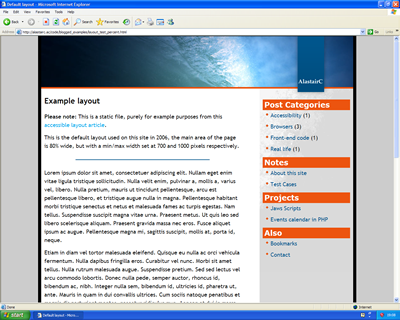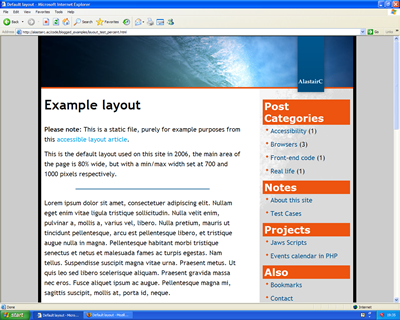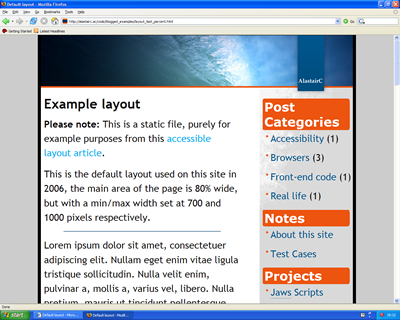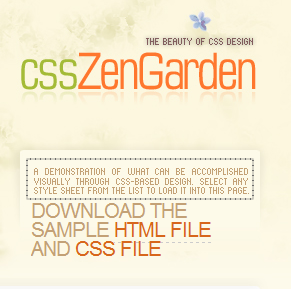Translations
 There are several options available for increasing the apparent size of web pages, from simple increases in text size, to full screen magnification. Focusing on browsers, I’ll examine what options suit different people, and what implications this can have for web development.
There are several options available for increasing the apparent size of web pages, from simple increases in text size, to full screen magnification. Focusing on browsers, I’ll examine what options suit different people, and what implications this can have for web development.
Unfortunately, vision does not fit into easy categories. I’ll consider it a continuum for the purpose of looking at the types of magnification (i.e. from 20/20 vision to almost blind), just be aware that things like tunnel vision and colour blindness do not sit within the continuum.
Types of Zoom
There are two main types of ‘zooming’ function available in browsers: Magnification (a general increase-everything zoom), and Text zoom (increasing the font size). Neither of these are particularly well known amoungst regular internet users, but either can be helpful for a great number of people.
Increasing text size
Using a standard page with a percentage based layout (i.e. it flexes with screen size), increasing the text size works in a very similar way across Firefox and Safari. Internet Explorer has a relatively limited range of text sizes:
- IE6 at normal text size:

- IE6 at its largest text zoom setting

- IE6 with access settings for font sizes, at its largest text zoom setting

- Firefox at a very large text zoom setting

(NB: All screen shots from Windows were taken on a Virtual Machine running XP Pro, at 1280×1024, and with Cleartype on.)
IE6’s text-zoom may seem somewhat limited, but in general use on different web sites its larger setting is reasonable, especially if you use its accessibility settings to ignore specified font sizes. For those with mild visual impairment (e.g. me without my glasses), it is usually adequate.
There are two main problems stemming from how sites have been developed: inflexible sites, and text within images.
Non-’bulletproof’ sites
Many sites are developed without visual impairments (or non-IE browsers) in mind, and they try to lock the font sizes to fit the design. Locking font-sizes is only partially possible in IE on Windows, and not at all in other browsers. Sometimes the site designers don’t realise it will break when people force the use of larger font sizes, and using text-zoom will cause overlapping areas or hidden text on many sites:

Sites which are not designed with flexibility in mind can be a nightmare for people with mild to moderate visual impairments. The opposite approach is to allow for flexibility, which Dan Cederhom coined as Bulletproof web design.
This aspect of accessibility is covered in WCAG as using relative fonts, currently missing from WCAG V2.
Images showing text
Text which is displayed by using images will not expand when you increase the text size. If the text is reasonably large (e.g. the same or larger than the text at a large setting in Internet Explorer), then it won’t be a problem for those using text-zoom. However, small text within images can be a real problem:

The outlined text is an image, with text at about 6 pixels high, the second paragraph is the large size within IE6. No matter what settings you select in the browser, a text-zoom will not expand image-text.
This is the same portion of text shown with standard browser settings:

The example is from the CSS Zen Garden, and as a site intended to demonstrate CSS designs, the methods used are understandable and for some designs necessary. However, I wouldn’t use image replacement techniques for general-public sites.
Using images for text is covered in use markup rather than images to convey information. The advantage of the image replacement technique is that (theoretically) the user can turn of the styling and get regular text. However, that is of little comfort to most people who don’t know how.
Magnification style zoom
Two browsers offer a type of zoom which increases the size of all elements: Opera and IE7. Opera has been doing this function for many years and several versions, IE7 is the new pretender with regard to zoom functionality. (NB: Firefox has an image zoom extension, but it isn’t aiming to be a general magnification tool.)
The IE team made a big deal about the IE7 zoom function, and the way it increases images looks great. It doesn’t just increase the size and create a large pixelated version of the image, it effectively re-sizes the image in a similar way to a graphics program, smoothing the image.
However, looking at the same image expanded with Opera 9’s zoom it is difficult to notice any difference – Opera must be employing a similar technique. (Compare the image, logo and icons on Yahoo at 400% in Opera and 400% in IE7.)
IE7’s zoom is useful for sites that use a narrow fixed width design like BBC news:
But the main disadvantage I’ve found with IE7’s zoom is that it often introduces horizontal scrolling, especially on sites using a liquid design. IE7’s style zoom would be useful for people on high-resolution monitors bumping up sites that have fixed their design at 800px wide, but it is not useful on sites with a larger width or a flexible width.
Using the IE blog as an example, at 150% zoom you loose the right side navigation, and can’t read a whole line of text without scrolling:
Opera on the other hand employs a kind-of max-width, at least up to a point. The IE team is aware of this shortcoming, and it should be fixed in the next version of IE. Given that good CSS support is relatively new to IE, it could be hard work as the zoom functionality is probably closely tied with the rendering.
Rating the browsers
All of the popular browsers apart from Opera allow the user to increase text size, with the caveat that IE6 & IE7 only work for certain units, and won’t increase the oft-used pixel size fonts.
Opera and IE7 have a more advanced zoom functionality, that increases the size of all the elements on the page, not just the text.
| Function | IE6 | Safari | Firefox | IE7 | Opera |
|---|---|---|---|---|---|
| Text Zoom |  |
 |
 |
 |
 |
| Text zoom on any font unit |  |
 |
 |
 |
 |
| Magnifying zoom |  |
 |
 |
 |
 |
| Intelligent magnifying zoom |  |
 |
 |
 |
 |
Which is the best?
Generally speaking, people with mild visual impairments can usually just increase the text size for more comfortable reading, so any of the browsers except IE6 would do the job.
This is the same for people with a new laptop or monitor that has a high resolution for its size. For example, the Dots Per Inch (DPI) of a typical (old) 15″ monitor at 1024×768px is 85.3. My laptop monitor is 16″ with a native resolution of 1600×1200px, a DPI of 125 which makes text appear 1/3 smaller! (Logical DPIs.)
It has probably become clear that Opera has the best all-round zooming function if you need anything more than slightly bigger text, or if a site uses images to display small text. Opera’s zoom works on a greater range of sites, as the algorithms employed aim to reduce the horizontal scrolling, keeping sites usable at a greater magnification.
For people with moderate to severe visual impairments, Opera would be a good browser, but other aspects of the computer would be very difficult to use without a general screen magnifier.
Technorati Tags:


Thank you for your article. IMHO you missed one solution: to define not only the font-size but the complete layout using relative values. This would result in a zoom behavior similar to what IE7 offers now. You will also run into the problem with the horizontal scrolling, but I think this is much better then staying with the original width of a column and a larger font – the horizontal scrolling hides some information (that’s bad) but you can still access them – with the other solutions you can’t.
Best regards,
Detlef
Hi Detlef,
Had you seen my article on accessible layouts?
I’ve tested those type of layouts (that I would call “font-based” layouts) with users who have visual impairments, and they were worse than fixed layouts.
The bottom line is that unless you can implement a max-width (of 100%) in IE, they are not a good (accessible) solution.
I’ve been experimenting with IE’s expressions to get that working, but I’m slightly hampered by only having a Mac at home!
Except Safari, I’ve used all these browsers. For I use 1920×1200 screen resolution, the zooming is really important function to me. My score for these browsers is:
Firefox: sucks, only text size can be ajusted, pictures and frames have no change! Together with the mem leakage problem I dropped it;
IE & IE based browsers: tolerable, text, frames and texts can be magnified at the same ratio. But when zooming is performed the page scrolling is extremely slow.
Opera: excellent, maginification runs perfectly, and the scrolling speed is far better than IE.
One should mention that both Opera and Firefox offer to set a minimum text size which in my oppinion is a better text zoom that the one offered in IE. While IE zooms all text including already large fonts the aforementioned function only zoom those parts whose fonts are smaller than the minimum text size TO the minimum text size. This will at least leave parts of Non-’bulletproof’ sites intact. And in combination with the magnifier option it allows you to magnify less.
I do have a problem with Operas magnify option though, it’s fast but leaves something to be desired quality wise. Most likely is uses simply bilinear algorithms to magnify and thus looks especially ugly on magnified text. I’d preder a good bicubic interpolation as an option for pc with enough power to handle it.
Hi Timur Sen,
It’s probably worth dealing with text-zoom and page-zoom as separate functions, it gets to complicated to discuss otherwise. But I agree that a minimum text size is a useful feature (in fact, IE’s text sizing is still very poor in IE7).
I’m not sure what Opera could do about the image re-sizing, I did a comparison with IE7’s and they were pretty similar. Other people have found Opera’s image zoom quality better, although I take that with a pinch of salt.
Good work. You may be interested in a zoom test I did comparing how Opera and IE7 zoom images.
Also Mac users can zoom in on anything using the mouse wheel and CTRL. Handy this morning for trying to read the ludicrously tiny text in the Quicksilver help window!
Interesting, thanks Chris. Firefox 3 will include image zooming, and I think the method of providing larger images that are scaled down will grow in popularity as browser zooms improve.
You might find things are different on different platforms though? Even in Parallels, I think the rendering of fonts and images can be different on OSX. Would you like a screen shot of IE/Op/FF on Windows?
Hi Alastair,
Nice article. In the meantime, Firefox 3 is published: indeed a magnifying zoom function is added – intelligent (no horizontal scrolling in liquid designs).
Now the Comparison Table can be updated, with FF3 as winner: all 4 cells can be green!
(as a testcase I used http://www.cosbo.nl)